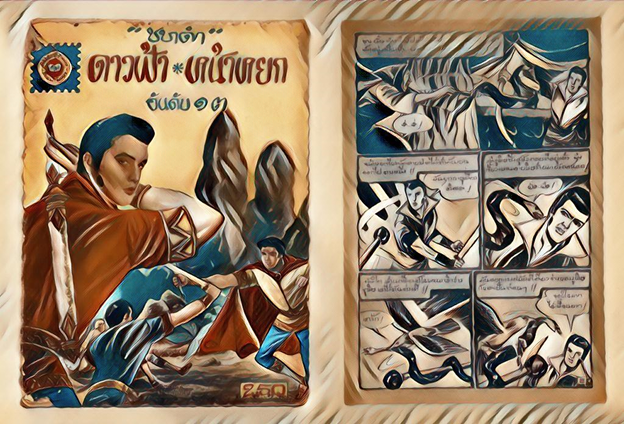
Discovering Thai Comics: A Cultural Treasure
Comic books have progressed from a niche interest in “nerd culture” to a vibrant and diverse form of entertainment with a major presence in mainstream society. Marvel’s charismatic Iron Man and DC’s somber Batman foreshadowed the impending media invasion, but their enormous impact on our daily lives was unforeseen. Comic book authors have developed fascinating stories that have caught consumers’ imaginations and gained the respect they deserve, from movies and video games to TV shows, lunch boxes, and other items.
While Western comic books have thrived, other forms of visual novels, such as Japanese manga, have evolved, gaining a bigger and more diversified audience as a result of blockbusters such as Ghost in the Shell, Edge of Tomorrow, and Alita: Battle Angel. Despite these achievements, there are other hidden gems waiting to be discovered, notably in the field of Thai comic books.
The Original Themes of Thai Comics
Since Thai comic books nowadays are mostly considered curiosities of a bygone era, they have not received what could be called proper study and attention, accepting certain very dedicated academics, so when we talk about “original” Thai comics subjects and themes, we are usually referring to publications that occurred between the 1920s and the 1970s, before Japanese manga began completely dominating the hearts and minds of young Thai children.
Comics in Thailand reflect a visual culture that can be traced back to the narrative elements of antique temple frescoes, while also showcasing versatility and inclusivity to outside influences, with topics ranging from religious musings to caricatures of political figures to science and their relation to the natural world. Imbued with a one-of-a-kind way of materializing folk stories and fusing foreign inspirations with local culture, Thai comics manage to seamlessly give characters like Superman and Elvis new, contextually specific meanings. Even the most unlikely of Western characters, such as a famous red-pants-wearing rodent that will not be named for fear of legal repercussions and a spinach-eating strongman, can wind up sharing the same body through the magic of Thai comic book creativity.
From British humor to monochrome films, US pop culture, Japanese manga, and other forms of worldwide contemporary culture, foreign influences on Thai comics mirror the broader societal repercussions of the time. During each age, whether it was about the political satire of the 1920s, the propaganda of the Cold War, royalism, democratic leanings, or even Thailand’s online casinos, cartoonists thoughtfully and enthusiastically depicted their country’s circumstances. This includes all aspects of Thai life, including mythology, customs, and economics.
Thai Comics Social Commentary
Thai cartoonists have a long history of using their work as a platform for social commentary, with even revered artists like Hem Vejakorn and Prayoon Chanawongse facing censorship at the hands of totalitarian regimes. Some artists have espoused traditionalist ideologies or allowed themselves to become instruments for political doctrine, while others, like the realists of the sixties and seventies, created counter-culture stories about the common folk. Admirably, Thai comics did not have the habit of ignoring real-life historical problems, including mass rape, migrant labor, changing gender roles, harsh rural living, oppression, and censorship, in addition to the more typical themes of fantasy, the paranormal, or superheroes.
The Downfall of Thai Comics
Thailand’s comic book industry is all but dead nowadays, with very few Thai artists taking interest in reviving the local flavor of comics. Of course, there are notable outliers like Prema Jatukanyaprateep, who won First Place at the International Manga Award ceremony in 2014 for her work on Bokbig. As there were no Thai comic books accessible to them, many Thai kids in the 1970s and beyond got a major chunk of their pop culture education from reading manga from Japan. Thai publishers like Vibulkij did not do much in the way of supporting local artists and started publishing translated Japanese manga in 1992, following the Japanese model of distributing weekly magazines with individual chapters from different series.
Reviving Thai Comics in the Digital Age
Nowadays, the way people consume comic book entertainment is undergoing significant changes as a result of technological developments. For starters, long-time industry giants NED (Nation Edutainment) and Vibulkij recently canceled two of Thailand’s oldest manga magazines, Boom and Viva Friday, much to the disappointment of many fans.
Although things seem bleak for NED and Vibulkij, Siam Inter Comics, another Thai comics publisher, doesn’t appear to be having the same issues. After relaunching their comic magazine in the online medium, they managed to become the first Thai comic magazine to effectively distribute new manga issues almost simultaneously with their Japanese release.
Final Thoughts
Perhaps now is the time for Thai artists to take another chance on comic books with the help of the online medium. In a world that’s hungrier for diversity and more open to comic books as an art form than ever before, this might be Thailand’s greatest chance since the 1930s to present its own take on the popular medium, with its own cultural influences and tropes, across the world wide web, where a much wider audience would have much easier access to the art of Thai comics.
Author Profile
Latest entries
 Comic Book NewsSeptember 12, 2025How to Get a Stable Internet at Comic Con Events for Vendors and Exhibitors
Comic Book NewsSeptember 12, 2025How to Get a Stable Internet at Comic Con Events for Vendors and Exhibitors CollectiblesMarch 26, 2025VeVe brings Disney charm to the digital world with the launch of the Beauty and the Beast collectibles set
CollectiblesMarch 26, 2025VeVe brings Disney charm to the digital world with the launch of the Beauty and the Beast collectibles set Comic Book NewsOctober 9, 2024Revisiting The Timeless Comic Book Adaptations From Yesteryear
Comic Book NewsOctober 9, 2024Revisiting The Timeless Comic Book Adaptations From Yesteryear ColumnsAugust 29, 2024How NSFW AI Chatbots Are Changing Dating and Relationships
ColumnsAugust 29, 2024How NSFW AI Chatbots Are Changing Dating and Relationships










